Catalogue of remarkable citizen innovations 2020 : 2. Environment/Air/Water/Biodiversity
The power of simple ideas that re-enchant the world !
septembre 2020
Innovation Citoyenne et Développement Durable (ICDD)
On the occasion of the Produrable 2020 exhibition, in a difficult context due to a particularly aggressive pandemic, which challenges our lifestyles, our ways of producing and trading, as well as our modes of governance, the ICDD association is pleased to present some thirty remarkable innovations or citizen initiatives that it is currently supporting
Concerning climate issues, or the necessary abandonment of fossil fuels in the short or medium term, it was frequently said in high places that a solution would be found: Each time a major problem was posed, it seemed that a solution was always found, until now.
« Don’t worry: we’re taking care of you and everything is under control: you can come and go as you please. In fact, it has become clear, especially with the arrival of the pesky and elusive Coronavirus, that this is not the case: our world is very fragile, and it doesn’t take much to suddenly stop the frenzy of human activity and confuse the Academies of Science, Medicine and Technology.
Things are becoming more problematic, more complex and more difficult to predict. Faced with the urgency of the situation, faced with the tragedies that are happening and that are occurring more and more frequently, we realise that it is urgent for everyone, and in particular all citizens, to be « on deck » and to see what they can do to participate in the resolution of the problems that collectively face us all.
Citizens have not waited to be asked to do so: they have long been aware of the issues at stake and, here and there, have devised solutions that are particularly relevant:
-
By their originality
-
By their simplicity
-
By their return to a common sense that had often been lost
-
By their concern for economy of means
-
By their sense of solidarity
-
By their formidable efficiency
The « problem » being that « we didn’t ask them anything »! It is therefore very difficult for their solutions to be heard, encouraged and supported, and then, once they have been developed, to be promoted to the extent of their potential impact, which is sometimes considerable.
The field of citizen innovation has never been so vast; it concerns all aspects of common life, all dimensions of the human ecosystem. To carry out our monitoring, we have focused on the priority expectations of citizens in a number of areas.
What could be more important for our health than the quality of the air we breathe? But industrial activities, most means of transport and poor heating systems pollute the air with significant repercussions, especially for people living in large cities or in confined valleys. Terraosave is able to deal with the issue of industrial fumes at low cost.
In terms of the environment, it is necessary for water to circulate in marshes, rivers, river mouths, etc. and for ponds and lakes not to get bogged down. This is particularly important for farmers who need water reserves to compensate for the increasingly frequent periods of drought: the Robot Dévaseur provides a solution to this problem, which was welcomed at the Paris Air Show.
Another problem: clean water. For humanity, this is undoubtedly the most important problem of the coming decades. With an ever-growing population, how can we have access to sufficient clean water for daily needs and disease prevention, especially for children? SafeWaterCube provides a surprisingly simple and powerful solution.
When it comes to preserving biodiversity, it seems that most minds are now set on this difficult issue. There is a remarkable and little-known innovation in this catalogue (Biohut) aimed at preserving the fish that are disappearing from our seas by helping fry to grow up safely along our coasts.
On each of these major environmental topics, here are four citizen innovations that can « change the game » and address a significant part of the challenges we face.
Cleaning up industrial fumes
Based on the same hookah principle already used for Terraotherm (sheet 1.1), but applied this time to industrial fumes and able to adapt to high temperatures, the Terraosave process now allows us to :
-
Recover the heat from these fumes
-
Filter the dust and virtually eliminate the gases and chemical vapours they may contain
When stirred by water, these fumes (from 400 to more than 1000°) are cooled; the heated water absorbs the dust and micro-dust in suspension, as well as the harmful gases. This technique has been validated in Dunkirk on an incinerator and the results have been validated by the official body Cofrac: 85 to 95% of the pollutants are thus recovered in the water. It is then easy to filter the polluted water and make it safe. See Sheet 2.1. and www.ademe.fr/terraosave .
This technology, developed by the company Starklab, is now spreading in France and Europe. But many other applications of national interest are possible: all that is needed is time and financial resources, which are difficult to obtain…
Note: given its low cost (because the energy in the fumes is recovered and therefore the heat), this technology should be made compulsory in particularly polluting industrial regions, such as Fos-sur-Mer, or the Arve Valley…
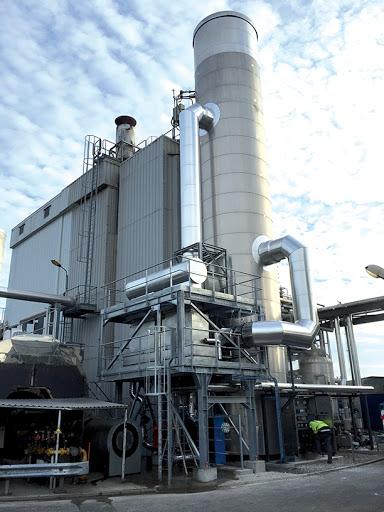
Preserving water reserves in lakes and ponds, and the circulation of water in rivers.
To solve this problem, the company E.S.T., which specialises in intervention in the sea bed, has devised a « de-silting robot ».
After several improvements to the prototype, the robot became operational in 2019. Installed in a pond in Creuse, it is intended to intervene in campsites or for municipalities. The device is rented by the month.
Rather than having a dredger come in once every ten years to remove the silt and deposit it further away, the silt removal robot proceeds by continuous cleaning (light but permanent silt removal), and the silt is no longer deposited « elsewhere », but is recovered for drying and return to the land.
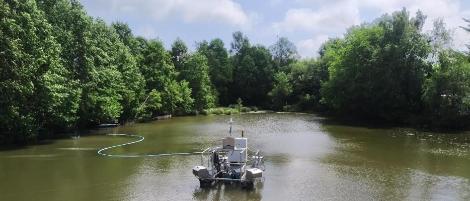
The sludge removal robot in France. Sheet 2.2 and robotdevaseur.com/
Saving water for agriculture.
Water is essential for plant growth. Except for land that is irrigated all year round, people are dependent on rainfall, which is becoming increasingly uncertain.
In response to this problem, a biochemist in the Gers region has developed an « organic » gel, Polyter: once placed in the ground, it is capable of absorbing 300 times its volume in water; it releases this water as and when the plant needs it. But this naturally enriched product has other virtues: it accelerates the development of the root system and the growth of plants; it regenerates plants and is biodegradable (certified analysis).
This product is now distributed throughout the world. Polyter’s customers include prize winners in « organic » products. Outside of agriculture, it has many applications: against desertification, it helps decisively in the creation of « green dams » in Africa; in cities, it facilitates the upkeep of green spaces and makes it possible to reduce water consumption by 50 to 80%, etc. Sheet 2.3. and www.polyter.com/fr/
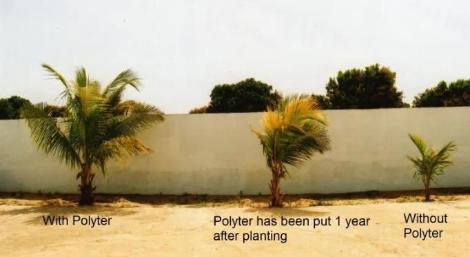
A photo rather than a long speech, two years after planting: « with Polyter », one year after the implementation of Polyter, and « without Polyter
Universal access to clean water
The earth needs water for plants to grow; but people need clean water to stay hydrated and healthy. Access to safe, ‘drinking’ water is vital, yet problematic in many areas. The lack of clean water is one of the major causes of infant mortality in the countries of the South, and is also one of the causes of many diseases that considerably slow down the development of the regions concerned.
The very simple and safe filtration process of raw water by porous ceramics has been well known for almost 150 years (English patent). It has been widely used in refugee camps with the blessing of the WHO for decades.
A humanitarian activist decided to promote this system in isolated villages in developing countries by increasing the water treatment capacity (installation in a box of 6 filters that work in parallel, so as to produce 1000 litres of healthy water per « village fountain » in one hour. The filtration is produced by a pressure provided by a mechanical system with human hands: no energy other than human power is necessary. This fountain is therefore completely independent of any other energy source. It should be noted that this type of ceramic filter, when properly maintained, is capable of filtering the finest particles present in water, including bacteria and viruses.
It should be noted that the installation of the drinking water fountain in the village is the subject of both a celebration and a « village contract » specifying the rights and duties of each person for the maintenance of the fountain, the cleaning of the filters and the access of all to water, in return for a contribution at marginal cost.
It is then a « starting point » for a renewal of village life and activity (schooling for children, revival of local agricultural and craft production, etc.). Nearly 400 villages have been involved to date in various countries (Asia, Africa, Latin America, etc.). It remains to pursue and accelerate this development as quickly as possible on the 5 continents, everywhere where clean water is cruelly lacking.

The SafeWaterCube fountain allows safe water sanitation recognised by the WHO. Sheet 2.4. and www.safewatercube.com/
Following the first developments of SafeWaterCube in Madagascar, a new project is being implemented with the French Water Partners, to bring safe water to a town of 50,000 inhabitants, which will eventually serve as a hub for the promotion of this solution on the island of Madagascar.
At the same time, near Nantes, a training centre has just been set up, operational from this summer, to train people in the problems and techniques of water purification and the market gardening that can be associated with it.
Re-populate the marine fauna on our coasts.
All the world’s seas are experiencing the « tragedy of the commons »: since the fish belong to everyone, if I am not the one catching the last fish, someone else will be… Based on this reasoning, the seas are gradually being emptied of all their fish.
This « tragedy » is compounded by another: the shores of the seas are veritable nurseries for many species of fish, crustaceans and molluscs. However, these shores are increasingly concreted over, making it impossible for the fry that leave the open sea to take refuge and feed there to develop. As a result, the life cycle of these species is diminished and this accelerates their extinction.
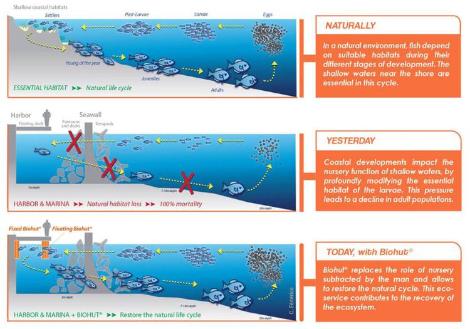
In response to this problem, of which few people are aware, ecologists specialising in marine fauna from the company Ecocean in Montpellier (created in 2003), have devised artificial nurseries to provide shelter and food for these young stages of marine animals.
These Biohuts (for biodiversity huts) are installed in marinas along the French and international coasts. Ecocean has already placed more than 3500 of these modules worldwide. Biohut has already identified nearly 300 different species of animals and helps save thousands of fry each year.
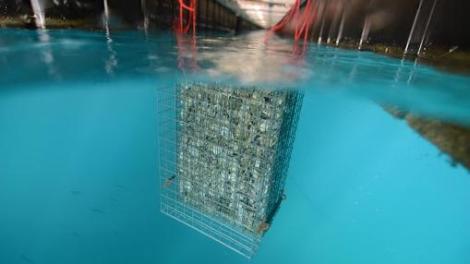
A Biohut nursery in a marina: The fry are protected from predators and can feed on the algae growing inside the « cage ».
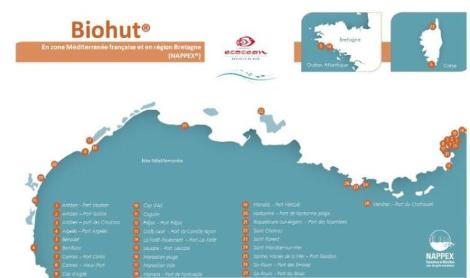
Setting up Biohuts on the French coast. Sheet 2.5. and www.ecocean.fr/
Ecocean is also involved in other ecological engineering projects in marine and freshwater environments.
Références
links to sheets : inks to the sheets see pdf doc attached(pdf/710 – icdd_rpertoire_des_innovations_citoyennes_produrable_200720.pdf)